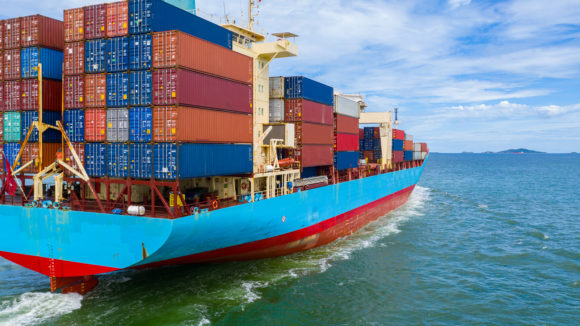Executive Summary: While the advancement of technology in electric vehicles and other lithium-ion powered goods facilitates energy transition from fossil fuels, the fire risks associated with such products need proactive management, writes Dr. William Moore, global loss prevention director, The American Club.
The bulker Genius Star XI was sailing 225 miles southwest of Alaska when its shipment of lithium-ion (Li-ion) batteries caught fire. It was a poignant reminder of the fact that the safe transportation of these batteries is a growing problem that must be addressed. Fortunately, the fire was extinguished, and all the crew were safe – this time.
The challenge lies with the law of probability. The fewer Li-ion batteries that are transported, the less chance there is of a fire breaking out. The problem, though, is that the quantity of Li-ion batteries is only increasing. The fires are caused by thermal runaway, which is when high temperatures create a chemical reaction within a lithium-ion cell, resulting in an uncontrollable self-heating state. This may then spread to other batteries onboard.
Fire a Growing Risk to Shipping Because of Lithium-ion Batteries, Allianz Says
The International Energy Agency recently reported that electric car sales exceeded 10 million in 2022, constituting 14% of all new car sales, up from 9% in 2021 and less than 5% in 2020. And according to S&P, that number will reach more than one in four cars by 2030.
Such an increase will lead to higher rates of transportation of electric vehicles (EVs) batteries, thus exacerbating the problem.
Major insurers are claiming that the number of such incidents are increasing, while it’s clear that fires and explosions are now the most expensive cause of marine claims. In 2021, they are said to have accounted for 18% of US$9.2 billion in total losses.
Indeed, Mike Ingham, director of the Marine Division, at Gallagher noted that fires on car carriers have reached the point at which the vessel type is becoming hard to insure.
Late last year, Chubb launch a Lloyd’s of London consortium to provide coverage for risks associated with the transit and storage of lithium-ion batteries. This will be music to the ears of the maritime industry, but the safety caveats remain.
Added Responsibility for Seafarers
With a growing number of incidents, the development and usage of lithium batteries present significant challenges for seafarers, similar to those faced by shore-side firefighters. Of course, the major difference is that shore-side firefighters’ core purpose is to fight fires, unlike seafarers. In addition, they have external resources more readily available to them – unlike seafarers.
Li-ion batteries have become widely popular due to their high energy density and application in various devices, from consumer electronics to EVs. However, they also pose certain risks, such as thermal runaway, overheating, and the potential for fires and explosions. These risks are compounded in a maritime environment, where access to external help and resources may be limited. Indeed, we have seen the results in tragic sinkings of car carriers such as the Felicity Ace in February 2022 – the 60,000 tonne roll-on/roll-off cargo ship (pure car/truck carrier) built by Shin Kurushima Dockyard in 2005.
The advancement of technology in EVs and other Li-ion powered goods is, of course, helping the maritime industry – and industries in general – to facilitate its energy transition away from fossil fuels and into alternative fuels for propulsion such as ammonia and hydrogen.
However, this only increases safety risks and amplifies the demand not only for proficient seafarers who can navigate these intricate systems, but research and development to best prepare for the scenarios we will inevitably face in their long-term use.
Human error has always been the major contributor to maritime casualties and the fast pace of new technologies will not only create new types of risk to manage, but will exacerbate the already high probability of accidents as a result of it.
While statistics so far show that the likelihood of casualties or fires related to Li-ion batteries is not heightened as compared with traditional energy sources, the real issue is that lithium battery fires are more difficult to control and extinguish due to their ability to reignite even after apparent extinguishment. In the case of the bulker Genius Star XI, the response personnel were forced to offload CO2 bottles for inspection, refill, and reinstallation, while members of the salvage team remained onboard with the ship’s crew throughout the extreme weather to monitor the vessel’s condition.
A one-mile safety zone was also placed around the vessel, and mariners who wished to enter that zone needed to request permission on VHF Channel 16.
If the use of Li-ion batteries as an alternative car propulsion is to continue with sea carriage as the method of transport for the trade, then will seafarers, on top of the already heavy lift of training, also need to be trained in advanced firefighting techniques specific to lithium battery fires? It is clear that the advancement of technology continues to outpace training efforts, resulting in a widening gap between the skills required and those available.
Safety Measures Improving
The move towards Li-ion battery powered vehicles and products is continuing at force and, while hope remains that the advancement in these products will mean an increase in their safe usage too, the focus for now must be on how to reduce the risks associated with them.
Additional safety measures are now being put in place by major vehicle carrier operators, which include the charging of Li-ion batteries to just 30%. This lower state of charge means a reduced risk of a battery going into thermal runaway, should a fire occur. Previously, lithium-ion batteries were normally charged up to 70%.
More work needs to be done to improve the probability of safe transportation, but the industry is taking action where it’s needed.
For 2024 and beyond, proactive engagement with both industry stakeholders and regulators on this issue is paramount. The American Club recognizes the urgency in fostering ongoing conversations to address the evolving risks associated with Li-ion technologies.
By collaborating with regulatory bodies, insurers, and other industry players, we can collectively work towards implementing robust safety protocols and guidelines to mitigate the potential hazards posed by Li-ion batteries. Through proactive measures and a commitment to continuous improvement, we can ensure the safe transportation of these batteries while supporting the transition towards sustainable energy solutions.
Photograph: In this undated photo provided by the Portuguese Navy, smoke billows from the burning Felicity Ace car transport ship as seen from the Portuguese Navy NPR Setubal ship southeast of the mid-Atlantic Portuguese Azores Islands.The blaze on the ship carrying around 4,000 vehicles made by Volkswagen Group broke out on Feb. 16, 2022 and sank two weeks later. All 22 crew members were rescued safely. (Portuguese Navy via AP)
Related:
- Lithium-Ion Battery Fire on Ship off Alaska out After Several Days of Burning
- Viewpoint: A New Risk Landscape Emerges for Global Maritime Industry
- Update: Burning Car Carrier Off Dutch Coast Towed Away From Shipping Lanes
- Volkswagen Faces Pair of Lawsuits Over Claim Porsche EV Battery Sparked Ship Fire
- Shipping Industry Grapples With Ways to Cut Cargo Fires at Sea
Was this article valuable?
Here are more articles you may enjoy.


 Tesla Showroom Strikes, Vandalism Sparked by Fury Against Musk
Tesla Showroom Strikes, Vandalism Sparked by Fury Against Musk  FAA Must Do Better After Midair Collision, Acting Chief Says
FAA Must Do Better After Midair Collision, Acting Chief Says  State Farm Has Paid $2.5 Billion in Claims for LA Wildfires
State Farm Has Paid $2.5 Billion in Claims for LA Wildfires  Trump’s Tariffs Threaten to Endanger the Cheap American Car
Trump’s Tariffs Threaten to Endanger the Cheap American Car 